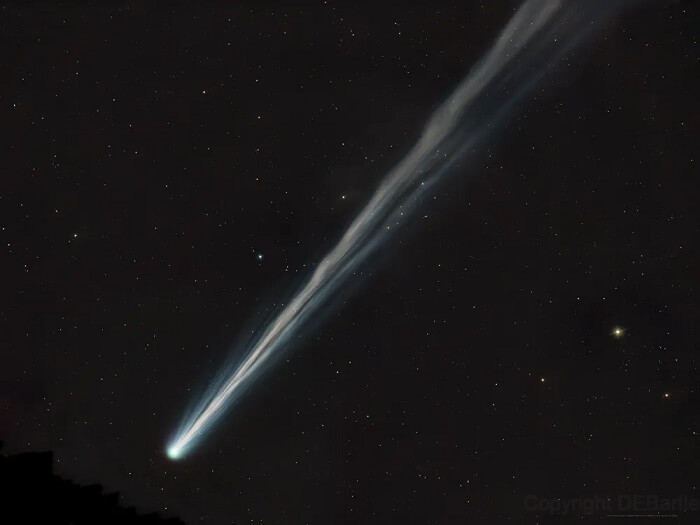
Newly Discovered Green Comet is Passing by Earth This Week
Comet Nishimura, which appears only once every 435 years, is on track to approach the sun and shoot into deep space
By: Will Sullivan | Smithsonian
Over the last several days, stargazers have caught sight of a newly discovered, green comet racing across the sky.
Comet Nishimura, named after the amateur astronomer who first photographed it about a month ago, will pass nearest to Earth on Tuesday before reaching its closest distance to the sun on September 17.
After slingshotting around the star, the comet will shoot off into space. It isn’t expected to return for around 435 years, making glimpsing Nishimura a once-in-a-lifetime opportunity.
Over the weekend, people took advantage of this rare chance to see the comet, when it appeared near the constellation Leo before sunrise, writes Alison Klesman for Astronomy.
“Humans From Another Galaxy Sent S0S Signals & NASA Received Them”
While Nishimura may still be visible this week, it will now be harder to see, since it’s appearing in the sky closer to sunrise when light can obscure it, according to EarthSky.
“You really need a good pair of binoculars to pick it out, and you also need to know where to look,” Paul Chodas, the manager of NASA’s Centre for Near-Earth Object Studies, tells Marcia Dunn of the Associated Press (AP).
What is Comet Nishimura?
Petr Horalek in Zahradne, Slovakia, made this composite image of Comet Nishimura (left) and Venus, the brightest planet, from images he captured on Saturday. He said: "I am truly happy I made it at least once to see this beauty!" Thank you, Petr! ☄️📸https://t.co/3B47e7PH8A pic.twitter.com/f3Fvyb1B5e
— EarthSky (@earthskyscience) September 11, 2023
Japanese astronomer Hideo Nishimura discovered his eponymous comet on August 12 from 30-second exposures made with a digital camera.
Officially called C/2023 E1, the comet has a green head and a long, white tail, and it measures about a half-mile in diameter.
Comets orbit the sun and are composed of frozen gases, rock and dust. Comet Nishimura likely originated in the Oort Cloud, a far-away, mammoth collection of icy objects on the edge of the solar system.
The distance from the Oort Cloud’s inner edge to the sun is thought to be 2,000 to 5,000 times greater than the distance between Earth and the sun, according to NASA.
🪐✨ Look at this amazing picture of Comet Nishimura (C/2023 P1) taken on September 5, 2023, by the talented @SebastianVoltmr! 📸✨
You can see this fantastic comet without needing a telescope right now! Read our article for all the details: https://t.co/mI6LFRFU5F 🚀🌟 pic.twitter.com/bzfn0VMRqN
— Star Walk (@StarWalk) September 11, 2023
What’s next for the Comet?
As Comet Nishimura travels closer to the sun, it’s getting brighter. It will continue to increase in brightness until September 17, Quanzhi Ye, an astronomer at the University of Maryland, tells the Washington Post’s Justine McDaniel.
But the comet will become more difficult to see after Monday, as it falls below the horizon and becomes outshone by the sun, Vishnu Reddy, an astronomer at the University of Arizona, tells Katrina Miller of the New York Times. Skywatchers who can view the cosmos from a mountain just before sunrise might have the best chance of spotting the comet, per the Post.
On Tuesday, the comet will pass within 78 million miles of Earth, the closest it will get to our planet. While the icy object could disintegrate as it approaches the sun, “it’s likely to survive its passage,” Chodas tells the AP.
The comet should pass within 27 million miles of the sun, per EarthSky—a few million miles closer than Mercury, the innermost planet, ever gets.
People in the Northern Hemisphere will likely be unable to see Comet Nishimura after September 13, according to the Planetary Society. But it should become visible during the evening in the Southern Hemisphere by the end of the month, Gianluca Masi, an astronomer and founder of the Virtual Telescope Project, tells the AP.
* * *
NEXT UP!
Scientists Have Created a Human “Entity” That Has No Mother or Father
Scientists all over the world continue to “play God”, and we are all going to have to live with the consequences.
Every single day, incredibly bizarre experiments are being conducted in secret laboratories all over the planet. I have frequently warned my readers about the very deadly diseases that are being developed in such laboratories, but other types of extremely sick experiments are happening as well. For example, it is being reported that one team of researchers has now been able to create a human “entity” that does not have a mother or a father.
In fact, it was created “without using sperm, an egg or a womb”…
* * *
More on Astronomy: What Does Space Smell Like?
Liked it? Take a second to support Collective Spark.
We’d love to hear from you! If you have a comment about this article or if you have a tip for a future Collective Spark Story please let us know below in the comment section.
